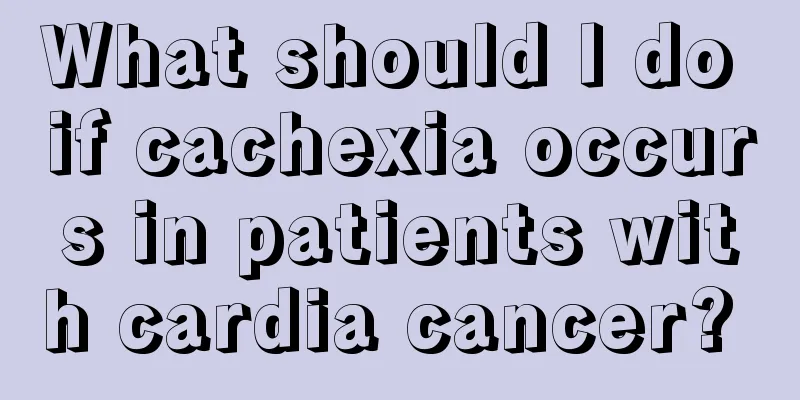What should I do if cachexia occurs in patients with cardia cancer?

|
After the onset of cachexia in patients with cardiac cancer, the clinical manifestations are varied. Among them, loss of appetite is often closely linked to cachexia and accompanies it. Loss of appetite is both one of the causes of cachexia and a clinical manifestation of cachexia. Loss of appetite is often the main complaint of many patients when they first visit the doctor. It is estimated that 25%-40% of cancer patients have loss of appetite when they seek medical treatment, and the rate is as high as 80% or more in advanced patients, and almost 100% when they are close to death. Cachexia in the late stage of cardiac cancer poses a great threat to the life and health of patients. For those who lose a lot of weight, the mortality rate is significantly increased, the effect of radiotherapy and chemotherapy is also very poor, and the patients themselves are already very weak, so it is not appropriate to use more traumatic treatment methods. This is because patients with cachexia often have low immune function and are prone to infection. After radiotherapy and chemotherapy, wound healing and tissue repair will be delayed, the clearance of drugs in the body will be slow, the toxicity will increase, and the gastrointestinal function will be weakened, which will aggravate the original malnutrition and form a vicious circle. Other common symptoms of cachexia include anorexia, nausea, weight loss, anemia, and muscle atrophy, which can eventually lead to the loss of all fat and muscle, resulting in death. Anorexia is often an important symptom of cancer cachexia syndrome, and was originally thought to be the main cause of weight loss. However, studies have found that anorexia is the result of cachexia rather than the cause. Another common symptom of cachexia is malnutrition. Malnutrition is divided into protein malnutrition, protein-energy malnutrition, and mixed malnutrition. The first type is mainly seen in patients who have not been ill for a long time. It is characterized by the lack of characteristics of malnutrition and only abnormalities in laboratory tests, so it is easy to be ignored. The second type is more common in patients with advanced tumors. The symptoms, signs and auxiliary examinations of malnutrition have already appeared, so it is easy to make a diagnosis. The last type of patients have obvious cachexia, with severe loss of fat and protein in the body, damage to the functions of important organs, and prone to complications such as infection. Malnutrition is sometimes closely related to the presence of cancer. After the cancer is removed, the nutritional status can often be restored to varying degrees. Patients with cachexia in the late stage of cardiac cancer may have some special signs such as spoon-shaped nails, koilonychia (iron deficiency), petechiae, ecchymoses (vitamin C, K deficiency), pigmentation, skin keratinization (niacin and vitamin A deficiency), etc. Although these are uncommon symptoms, they may cause vigilance for patients and clinicians. Cardiac cancer: http://www..com.cn/zhongliu/bma/ |
<<: How much do you know about the treatment of cardia cancer?
>>: What symptoms can distinguish melanoma from melanoma?
Recommend
How should lung cancer patients do a good job of nursing? Lung cancer patients should pay attention to three nursing tasks
There are many lung cancer patients around us, so...
Will bile duct cancer be passed on to children?
Before introducing whether bile duct cancer can b...
Is it serious to have a bone tumor on the head
There are many times when you feel dizzy and have...
Summer wedding dress
The most important thing in a person's life i...
What are some ways to fall asleep quickly?
The quality of sleep has a great impact on the bo...
Is interventional treatment useful for advanced liver cancer? It has a certain effect
Interventional treatment for advanced liver cance...
"Air conditioning disease" is common in summer, you no longer have to worry about it with 4 Chinese medicine prescriptions
As summer approaches and the weather becomes hot,...
How to treat cervical cancer if surgery is not possible
Cervical cancer has become the biggest enemy thre...
Five methods of TCM for treating nasopharyngeal carcinoma
In traditional Chinese medicine, nasopharyngeal c...
Life expectancy after surgery for advanced liver cancer
How long can a liver cancer patient generally liv...
Introduction to several common symptoms of skin cancer
Skin cancer is a cancer disease with a racial ten...
What are the causes and treatments for nausea and vomiting when getting up in the morning
Some people feel nauseous and want to vomit when ...
What are the symptoms of mucositis?
The oral mucosa is a simple skin tissue, and comp...
What is the face shape of apple muscles
The apple muscles cannot represent your face shap...
Symptoms of melanoma in pregnant women
What are the symptoms of melanoma in pregnant wom...









